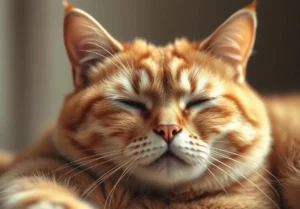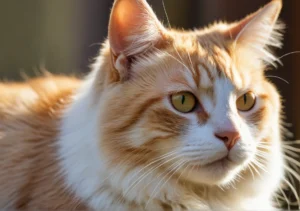Cats always seem to be on edge, ready to pounce at the slightest noise or movement. But why is that? What causes our feline friends to be in a constant state of alertness?
The Evolutionary Explanation
Cats are always on edge due to their evolutionary instincts honed over centuries. In the wild, being constantly alert helped them survive and thrive. Even though cats have been domesticated, this instinct remains deeply ingrained in their behavior. They are predisposed to be on high alert for any potential threats, no matter how safe their environment may seem to us. This constant vigilance is a testament to their ancestors’ adaptability and survival skills, ensuring that they are always ready to react swiftly to any perceived danger.
Sensory Overload
Cats’ keen senses play a significant role in why they are always on edge. Their sharp eyesight, acute hearing, and heightened sense of smell make them highly sensitive to their surroundings. For cats, even the slightest sound or movement can trigger a response, keeping them in a state of readiness at all times. Imagine having superhuman senses that can detect the faintest squeak or rustle – that’s what it’s like for a cat! This sensory overload can easily overwhelm them, leading to a heightened state of alertness and a quick response to perceived threats.
Unique Insight: Cats’ whiskers are not just cute accessories; they serve a crucial sensory function. Whiskers help cats navigate their surroundings and gauge distances, adding another layer to their already sharp senses. So, next time you notice your cat’s whiskers twitching, know that they are utilizing this sensory tool to stay on top of their game.
Remember, understanding why cats are always on edge can help us better appreciate and respect their natural instincts. By creating a safe and secure environment for our feline friends, we can help them feel more at ease and reduce their constant state of alertness.
Anxiety Triggers
Changes in a cat’s environment, loud noises, or unfamiliar people are common triggers for anxiety in cats. Cats are creatures of habit and thrive on routine, so any disruption can cause stress and make them appear on edge. To help your cat feel more comfortable, try to maintain a consistent environment and provide them with plenty of hiding spots where they can feel safe. Additionally, using calming pheromone diffusers or interactive toys can help reduce anxiety in your feline friend.
Medical Conditions
Certain medical conditions like hyperthyroidism or epilepsy can manifest in behavior that makes cats appear on edge. If you notice your cat displaying unusual behavior such as increased aggression or restlessness, it’s essential to consult with your veterinarian for proper diagnosis and treatment. Hyperthyroidism, for example, can cause cats to be more irritable and anxious, while epilepsy can lead to sudden episodes of hyperactivity and agitation. Seeking professional help is crucial in managing these conditions and helping your cat feel more at ease.
Unique Insight: Signs of Stress
In addition to changes in environment and medical conditions, it’s important to recognize the signs of stress in cats. Excessive grooming, hiding, or aggression towards humans or other pets can all indicate that your cat is feeling overwhelmed. By being aware of these signs and addressing the underlying causes, you can help your cat feel more relaxed and secure in their surroundings. Taking proactive steps to reduce stress can greatly improve your cat’s overall well-being and demeanor.
Signs of Stress in Cats: 1. Excessive grooming or overlicking 2. Hiding or avoiding interaction 3. Aggression towards humans or other animals 4. Changes in appetite or litter box habits 5. Increased vocalization or restlessness
By keeping an eye out for these signs and addressing them promptly, you can help your cat feel more at ease and less on edge in their daily life.
Playtime and Enrichment
Is your cat always on edge? Providing mental and physical stimulation through playtime and environmental enrichment can work wonders in reducing their stress and anxiety. Cats are natural hunters, so engaging them in interactive play sessions with toys like feather wands or laser pointers can help satisfy their innate instincts and keep them mentally sharp. Additionally, creating a stimulating environment with scratching posts, climbing trees, and puzzle feeders can offer your feline friend the mental enrichment they need to feel more at ease.
Here are some tips for playtime and enrichment: – Rotate Toys: Keep things fresh by rotating your cat’s toys regularly to prevent boredom. – Catnip Fun: Sprinkle some catnip on scratching posts or toys to entice your furry friend to play. – DIY Toys: Get creative and make your own cat toys from household items like cardboard boxes or toilet paper rolls. – Quiet Time: Allow your cat to have some quiet time away from loud noises or overly active environments to help them relax.
Establishing Routine
Feeling like your cat is always on edge? Establishing a consistent daily routine can play a significant role in helping your feline friend feel more secure and less anxious. Cats thrive on predictability, so providing them with regular meal times, play sessions, and sleep schedules can give them a sense of stability in their environment. By setting up a structured routine, you can help reduce stress and create a lasting sense of comfort for your furry companion.
Additional unique insight: – Mealtime Rituals: Incorporate interactive feeder toys or puzzle feeders during meal times to engage your cat’s mind and add a fun element to their routine.
Remember, a happy and relaxed cat starts with providing them with the mental and physical stimulation they need, along with a reassuring routine they can rely on every day.
Calming Techniques
Hey there, if your cat is always on edge, there are some helpful calming techniques you can try out to bring them some much-needed relaxation. Pheromone therapy is a fantastic option – it involves using synthetic hormones to create a soothing environment for your furry friend. Calming supplements are also worth considering, as they can help reduce anxiety and promote a sense of calm in your cat. These techniques can work wonders in helping your cat feel more at ease in their environment.
Quiet Spaces
Creating quiet spaces for your cat is crucial when they’re feeling overwhelmed. Cats need their own safe havens where they can retreat and relax when the world feels too chaotic. Make sure to provide cozy hiding spots, cat trees, or even a comfortable blanket in a secluded area of your home. These quiet spaces give your cat the perfect opportunity to unwind and recharge away from any potential stressors.
Additional Unique Insight:
– Providing vertical space for your cat, such as cat trees or shelves, can also help reduce their stress levels by allowing them to escape to a higher vantage point where they feel more secure.
Fun Fact: Cats’ Whiskers
Did you know that a cat’s whiskers are not just for show? These specialized sensory hairs are vital for helping cats navigate their surroundings and remain alert. Cats use their whiskers to detect changes in air currents, which can alert them to approaching danger or prey. The length of a cat’s whiskers is roughly equal to the width of its body, acting as a built-in measuring tool to help them assess whether they can fit through tight spaces. So, next time you see a cat’s whiskers twitching, they’re not just being cute – they’re staying sharp and on guard!
Expert Advice
Seeking guidance from veterinarians or animal behaviorists can offer valuable insights on managing a cat’s heightened state of vigilance. One common reason for a cat to be on edge is stress or anxiety, which can stem from changes in their environment, routine, or interactions with other pets. To help alleviate this, provide your cat with a safe space to retreat to when they feel overwhelmed. Additionally, engaging in interactive play sessions can help redirect their focus and expend excess energy. Remember, a calm and stable environment plays a significant role in keeping your feline friend feeling secure.
Expert Tips for Managing a Cat’s Vigilance: 1. Create a predictable routine to reduce uncertainty. 2. Provide vertical spaces like cat trees for climbing and observation. 3. Use pheromone diffusers or calming supplements under veterinary guidance. 4. Avoid sudden movements or loud noises that may startle your cat.
Remember, understanding and addressing your cat’s needs with patience and compassion can help them feel more secure and relaxed in their home environment.
Alex, a passionate animal lover, has experience in training and understanding animal behavior. As a proud pet parent to two dogs and three cats, he founded AnimalReport.net to share insights from animal experts and expand his knowledge of the animal kingdom.




